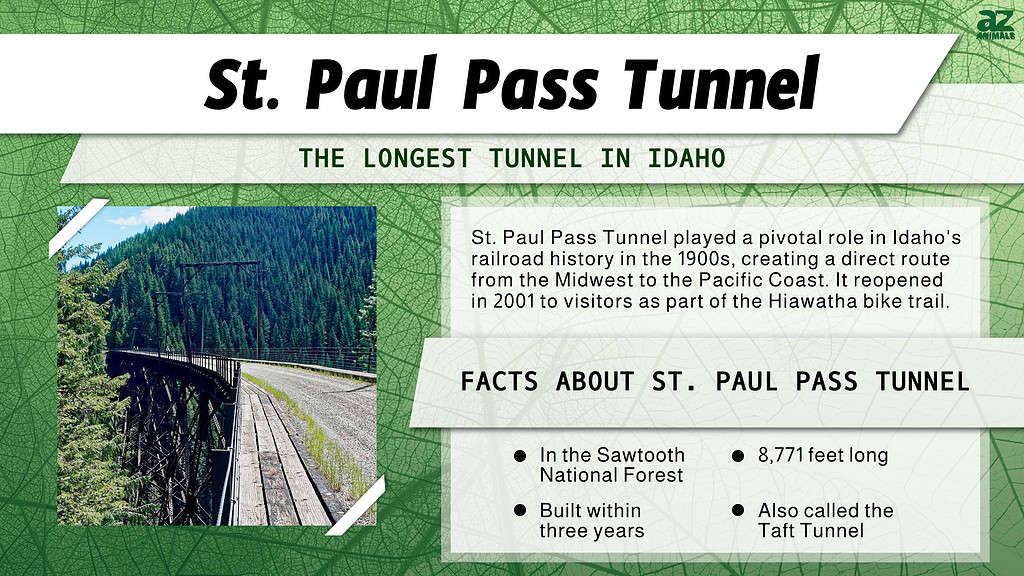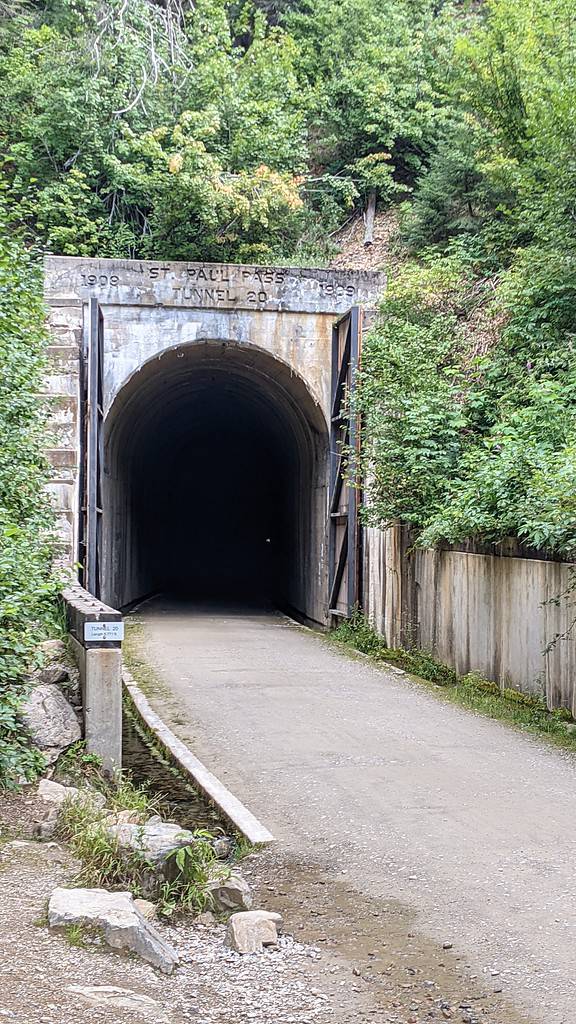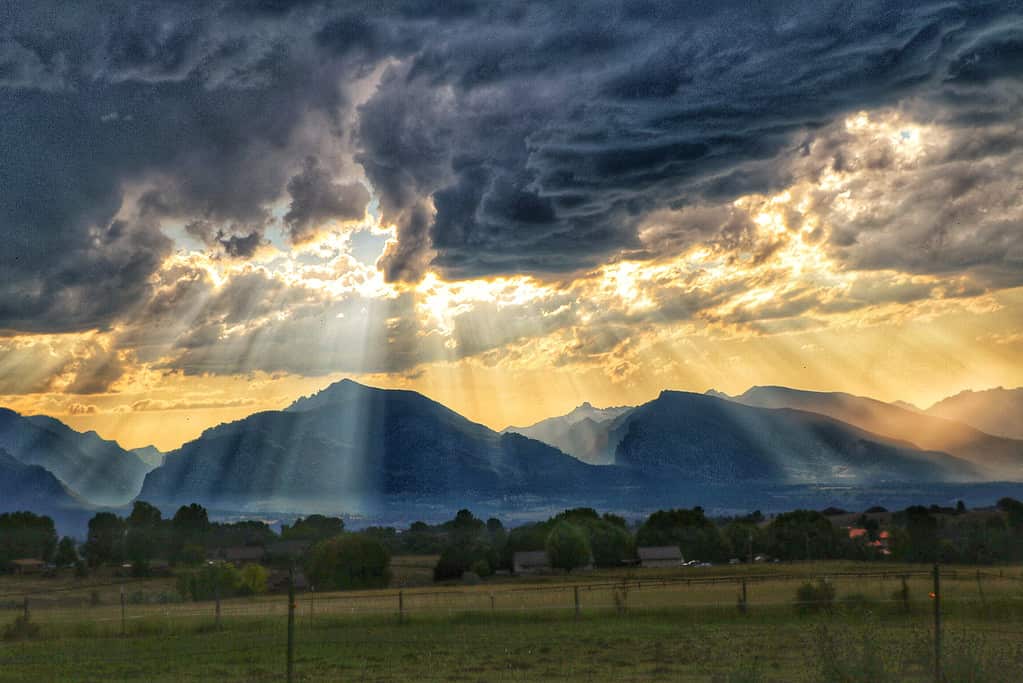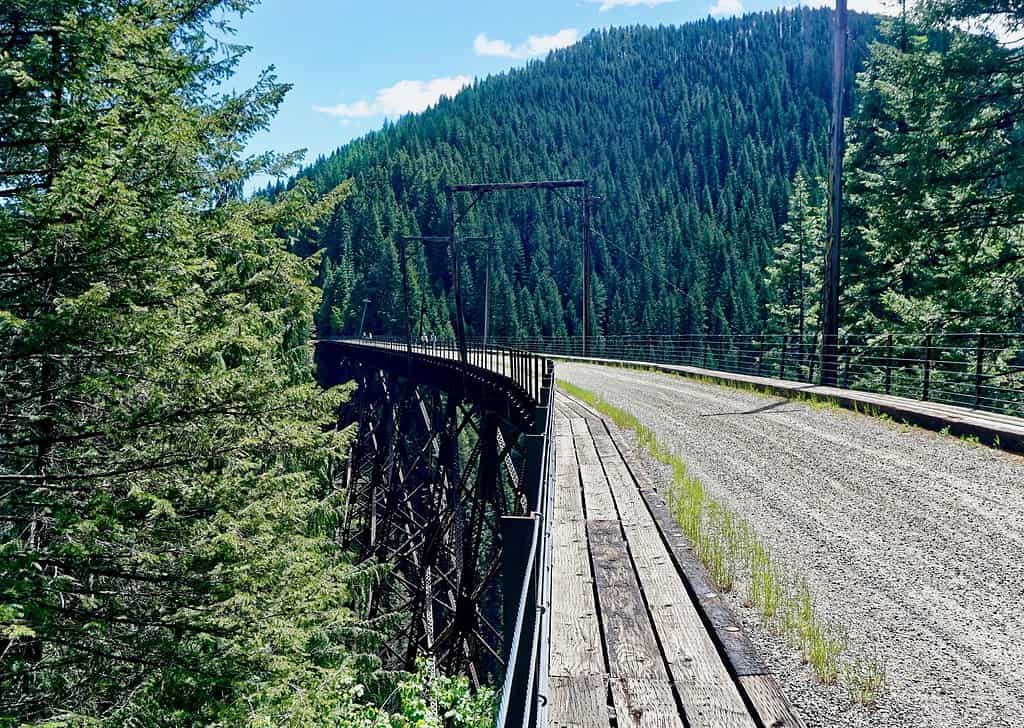Key Points:
- St. Paul Pass Tunnel, also called the Taft Tunnel, is the longest tunnel in Idaho.
- It spans 8,771 feet in length, or 1.66 miles, and its construction created a direct rail route during the 1900s from the Midwest to the Pacific Coast.
- Today, people can walk or bike the tunnel as part of the Route of the Hiawatha bike trail, which follows the historic railroad tracks through the Bitterroot Mountains.
Discovering a hidden gem in the Idaho wilderness is an experience unlike any other. Whether you’re into breathtaking scenery, stunning wildlife encounters, or interesting historical sites, this destination has something for everyone. It’s one of the longest tunnels in Idaho and offers visitors a unique adventure that they won’t soon forget. This tunnel is located in the Sawtooth National Forest and is nearly a mile long, so you’ll have plenty of time to explore its depths and enjoy the view along the way. Discover the beauty of this hidden gem in the Bitterroot Mountains and ensure it’s on your bucket list!

What Is the Longest Tunnel in Idaho?
The longest tunnel in Idaho is the St. Paul Pass Tunnel, also called the Taft Tunnel. Spanning over 8,771 feet in length, or 1.66 miles, the tunnel was constructed from 1906 to 1908 to create a direct route from the Midwest to the Pacific Coast.
However, the decline of railroad traffic in the 1950s combined with consolidation of larger railroads led to the abandonment of the trackage system in the Idaho-Montana area in 1980. The tunnel was left abandoned and unused until it was reopened on June 23, 2001 as part of the Route of the Hiawatha rail trail, which follows the historic railroad tracks through the Bitterroot Mountains.

The longest tunnel in Idaho is the St. Paul Pass Tunnel, also called the Taft Tunnel.
©Wyked111, CC BY-SA 4.0 <https://creativecommons.org/licenses/by-sa/4.0>, via Wikimedia Commons – License
Exploring the Tunnel
Exploring the St. Paul Pass Tunnel is a unique and unforgettable experience. Visitors can access the tunnel via the Route of the Hiawatha bike trail. The trail is mostly downhill, making it an easy ride for most visitors. Visitors will pass through several historic tunnels and trestles, including the St. Paul Pass Tunnel and the Taft Trestle.
The tunnel is pitch black and over a mile long, so visitors must bring a flashlight or headlamp to see their way. The tunnel is also very cold, even in the summer, so visitors should bring warm clothing to stay comfortable. The tunnel’s walls are made of rough-hewn rock, and visitors can see the marks left by the workers who dug the tunnel over a century ago.
The tunnel is open during summer and is a popular destination for hikers, bikers, and sightseers. As visitors enter the cool darkness of the tunnel, they are transported to another world. The bright daylight on either side of the tunnel creates an eerie atmosphere one must experience to truly appreciate.

The Bitterroot Mountains surround the St. Paul Pass Tunnel.
©TylorOlsen/Shutterstock.com
Wildlife Around St. Paul Pass Tunnel
The Bitterroot Mountains surrounding the St. Paul Pass Tunnel are home to various wildlife, including bears, mountain lions, elk, and birds. Visitors should take precautions to avoid encountering these animals, such as carrying bear spray and making noise to avoid surprising wildlife. The area is also popular among birdwatchers, as it is home to many species of birds, including eagles, hawks, and owls.
The Role of St. Paul Pass Tunnel in Idaho’s Railroad History
The St. Paul Pass Tunnel, also known as the Taft Tunnel, played a pivotal role in Idaho’s railroad. The Northern Pacific Railway created a direct route from the Midwest to the Pacific Coast. Completing the tunnel and the railroad line profoundly impacted the state’s economy and culture, shaping the lives of the people who lived and worked in the region.
Before the construction of the St. Paul Pass Tunnel, transportation across the Bitterroot Mountains was difficult and dangerous. The mountains presented a significant obstacle to travel and commerce, with steep slopes, dense forests, and rocky terrain making travel by foot or wagon almost impossible. Completing the railroad line and the tunnel changed everything, providing a safe and efficient way to transport people and goods across the mountains.
The workers who built the St. Paul Pass Tunnel encountered various difficulties during the massive engineering project. The workers had to deal with challenging circumstances while digging a tunnel through solid rock, including harsh weather conditions, difficult terrain, and hazardous wildlife. Even though there were difficulties, the tunnel was finished within three years. It still stands as a remarkable achievement in human creativity and technical expertise.

©iscellaneous Items in High Demand, PPOC, Library of Congress, Public domain, via Wikimedia Commons – License
What Is it Like Visiting?
Visiting the St. Paul Pass Tunnel is an insightful and fun experience that should be on every traveler’s bucket list. The tunnel and the surrounding wilderness offer a unique and unforgettable experience that will leave a lasting impression.
To visit the St. Paul Pass Tunnel, visitors should plan to take the Hiawatha bike trail, which is available from Memorial Day to Labor Day. Visitors can rent bikes and helmets at the trailhead, and they should bring warm clothing, a flashlight or headlamp, and bear spray if they plan to explore the tunnel.
The Route of the Hiawatha is a family-friendly bike trail suitable for riders of all ages and skill levels. The trail is easy for most visitors as it’s mostly downhill. Visitors can stop and take photos or soak in the stunning views.

The St. Paul Pass Tunnel is open to visitors as part of the Route of the Hiawatha bike trail.
©Kim Grosz/Shutterstock.com
Are There Any Other Visit-Worthy Places Nearby?
Many visit-worthy places are nearby the St. Paul Pass Tunnel in the Bitterroot Mountains. Here are some suggestions:
Lookout Pass Ski and Recreation Area
Located just a few miles west of the St. Paul Pass Tunnel, Lookout Pass Ski and Recreation Area offers skiing, snowboarding, and other winter activities during the winter months. Visitors can enjoy hiking, mountain biking, and scenic chairlift rides during the summer.
Youree Drive-In Theater
Located in nearby Wallace, Idaho, the Youree Drive-In Theater is a classic drive-in movie theater that has been open since 1955. Visitors can enjoy a vintage experience while watching the latest movies on the big screen.
St. Joe River
The St. Joe River is a popular destination for fishing, camping, and rafting in the summer months. Visitors can explore the river by paddling a canoe or kayak and enjoy views of the mountains and wildlife, including eagles, hawks, and owls.
Historic Wallace, Idaho
If you’re interested in Idaho’s mining history, visit the historic town of Wallace, Idaho, located about 30 minutes east of the St. Paul Pass Tunnel. The town boasts several museums and historic buildings, including the Wallace District Mining Museum and the Northern Pacific Depot Railroad Museum.
Coeur d’Alene Lake
Coeur d’Alene Lake is a picturesque lake in Idaho approximately 1.5 hours west of the St. Paul Pass Tunnel. The lake is perfect for water activities such as fishing, swimming, and boating. It is also a popular destination for outdoor enthusiasts due to its stunning mountain and forest surroundings.

Coeur d’Alene Lake is a picturesque lake in Idaho approximately 1.5 hours west of the St. Paul Pass Tunnel.
©Inland Northwest Visuals/Shutterstock.com
Garnet Ghost Town
Garnet Ghost Town is a historical mining town from the late 1800s, located around two hours northeast of the St. Paul Pass Tunnel. Visitors can gain insight into Idaho’s mining history by exploring the various well-preserved buildings and learning about life in a mining town during that era.

Garnet Ghost Town is a historical mining town from the late 1800s.
©Nagel Photography/Shutterstock.com
Silver Mountain Resort
Silver Mountain Resort is situated 90 minutes to the East of St. Paul Pass Tunnel. During the winter, you can take part in skiing, snowboarding, and other wintertime pursuits, while venturing out for hikes, biking up mountains, and taking in the sights from gondola rides are activities available during the summer. The resort also has an indoor water park, making it an ideal spot for families.
Where Is St. Paul Pass Tunnel Located on a Map?
The Taft Tunnel goes through the St. Paul Pass in the Bitterroot Mountains, so it is also called the St. Paul Pass Tunnel. The name Taft was given to the work camp and tunnel for those who built the tunnel because, the legend says, President William Howard Taft visited there when he was serving as Secretary of War under President Teddy Roosevelt. The tunnel is next to the Idaho/Montana border.
Conclusion
The St. Paul Pass Tunnel is a remarkable engineering feat and a must-see spot for those fascinated by Idaho’s history or natural scenery. It’s the longest tunnel in Idaho, stretching over a mile, and provides visitors with a one-of-a-kind and unforgettable adventure.
Take precautions against wildlife encounters and bring appropriate gear, like warm clothing and a flashlight, when visiting the St. Paul Pass Tunnel and the Route of the Hiawatha bike trail. Located in the Bitterroot Mountains, these areas offer breathtaking views of the surrounding wilderness and various wildlife. This experience is a must-try for any traveler’s bucket list.
The photo featured at the top of this post is © Kim Grosz/Shutterstock.com
Thank you for reading! Have some feedback for us? Contact the AZ Animals editorial team.






